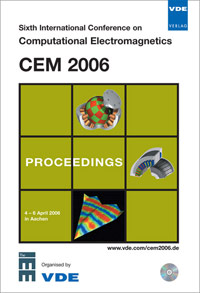Maxwell’s equations in accelerated frames - How do they relate to Computational Electromagnetics?
Conference: CEM 2006 - 6th International Conference on Computational Electromagnetics
04/04/2006 - 04/06/2006 at Aachen, Germany
Proceedings: CEM 2006
Pages: 3Language: englishTyp: PDF
Personal VDE Members are entitled to a 10% discount on this title
Authors:
Kurz, Stefan (Robert Bosch GmbH, Research and Advance Engineering, 60461 Frankfurt, Germany)
Flemisch, Bernd; Wohlmuth, Barbara (Universität Stuttgart, Fachbereich Mathematik, 70569 Stuttgart, Germany)
Abstract:
In many engineering applications the interaction between the electromagnetic field and moving bodies is of great interest. It is natural to use a Lagrangian description, where the unknowns are defined on a mesh which moves and deforms together with the considered objects. What is the correct form of Maxwell’s equations and the material laws under such circumstances? The aim of the present paper is to tackle this question by using the language of differential forms. We first provide a review of the formulations of electrodynamics in terms of vector fields, as well as differential forms in the (1+3)- and four-dimensional setting. In order to keep both Maxwell’s and the constitutive equations as simple as possible, we set up two reference frames in addition to the laboratory frame. In the natural material frame, the (1+3)-Maxwell’s equations have their simple form, whereas in the the co-moving inertial frame, the material laws are canonical. It remains to construct transformation laws connecting the considered frames. To achieve this, we use a (1+3)-decomposition in terms of general projection operators which do primarily not depend on an underlying metric or on the choice of a spatial coordinate system. The desired transformation laws are established by comparing the different decompositions of an arbitrary p-form w.r.t. the considered frames. We provide an interpretation of these laws in terms of vector fields, and consider the low frequency limit, which is the most relevant case for an implementation into numerical codes.


